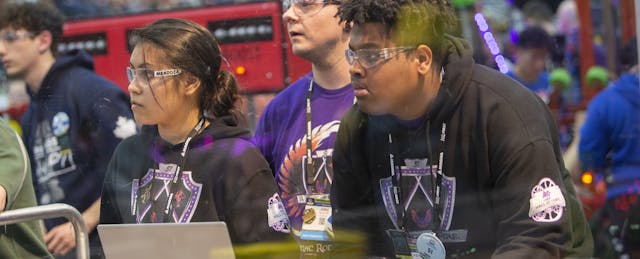Not every kindergartner can boast that she helped build a robot with high school students. But this is exactly what Kate Sample did, at the age of five, when her parents became actively involved in the FIRSTⓇ (For Inspiration and Recognition of Science and Technology) program at the high school in their small Kansas town.
Growing increasingly interested in robotics, Kate and her sister tagged along to team meetings and were invited by the older students to join in the build. This inclusive attitude had a significant impact on Kate as a child and is something she has carried with her into adulthood.
Supported by her engineer father, Kate continued her involvement in the FIRST program into high school. She saw how engaged her peers were in the activities, how they worked together and celebrated each individual’s skills and interests.
Those early experiences taught Kate about engineering and science, but she also learned about teamwork, communication and the value of supporting those around you. She has brought all of those skills into her work at AmeriCorps VISTA, now in her second year supporting the FIRST program in Florida and throughout the Southeastern United States.
We had a chat with Kate about her views on STEM education, supporting underrepresented and underserved students, and how learning to fail helps all kids succeed.
EdSurge: Not everyone has an engineer dad to support their passion for STEM. How do you think FIRST programs and STEM education impacted your peers or the other kids you worked with?
Kate Sample: I can give you a great example. One of my best friends in high school was on the robotics team with me. He came from what you would call an under-resourced area. Both of his parents were blue collar workers doing what they could to get by. He always enjoyed working with his hands and learning engineering concepts, but he never had a lot of that at home.
When he was introduced toFIRSTⓇ LEGOⓇ League, he learned all those skills, and he wanted to continue developing them when he was in high school. We both joined theFIRSTⓇ Robotics Competition team. As sophomores, we were in the computer-aided design (CAD) class together. Our teacher got a phone call from a local engineering firm saying, "Hey, we want some high school students to come in and revamp some of our CAD models. Do you have anyone?" The teacher turned to us and said, "Which one of you wants the job?"

My friend, as a sophomore in high school, became an intern for an engineering company, doing their computer-aided design work. He was doing CAD for bridges. He was doing structural design. He was learning about environmental engineering. He continued to do that and now he's one of the higher ups in the company. It was just a small startup in our tiny town, and it's grown. He currently works on bridge projects while going to college for his mechanical engineering degree with a minor in environmental and structural engineering.
What are some impacts you've seen from educating kids around STEM in the classroom?
One of the things I've seen is the way kids light up when you bring STEM to them. I work with a high school robotics team, and once a month, we go to an elementary school and bring a STEM activity. For example, we'll bring popsicle stick and rubber band catapults, and we'll explain the engineering principles. We'll let them experiment and build their own. We have teachers and principals that will tell us, "That kid hates school. That kid doesn't talk to any teachers. That kid doesn't like anything," and he's over there building a catapult, laughing, smiling, talking to the high school students, talking to his teachers, talking to other students. They ask, “Who is this kid?" This is a kid who cares because he's passionate about STEM, about trying something and failing and trying again.
It's so cool when you bring STEM to people how much more excited they get about trying and failing. When kids are in a school setting and they read a book and they take a test about the theme of that book and they fail, they feel so devastated inside. But when they build a catapult and it doesn't work, they think, "It's cool. I'll just rebuild it. I'll just change this." They don't see it as a failure. They see it as, "I have a new opportunity to try again." I think that's why STEM is so awesome to have in the classroom because it encourages failure and how to deal with it and how to grow from it.

Can you share an example of a student who has had an "aha" moment with STEM or robotics?
I think I have way too many because there's not a favorite. Every day, I can go out there and see those "aha" moments, kids just getting there, or finally it clicks and it makes it through. When we work with these teams, you might have students who are a little more confident and a little more experienced. Then you have students who are brand new, terrified, and don't want to fail because they don't know the joy that it brings when you fail at things and then you have success. They have someone who shows them, "You start here. Start with this one small piece. Try to code it to drive straight. Is there another way you can do that?"
Once they experience those little, tiny moments, they grow and develop into such incredible young people that are just going to outdo us all in the future. I can't wait for that.
Ignite Curiosity in Your Students
FIRST® was founded 31 years ago to inspire young people to become science and technology leaders and innovators. During this challenging time, their programs are helping educators continue to ignite curiosity in their students, and further develop the skills and confidence they need to change the world—today and tomorrow.
Now, more than ever, all kids need equitable access to opportunity, relevant mentorship and engagement to build a foundation for a bright future. To build a uniquely diverse and innovative workforce—one that can truly address the challenges facing today’s world—we need kids of all backgrounds and capabilities in the professional pipeline. High quality, inclusive, STEM learning and engagement opportunities can be life changing for young people in disenfranchised communities who otherwise might not have a direct pathway to the fast-growing STEM economy.
FIRST’s inclusive robotics programs encourage participation through an expanded team structure that allows young people to experiment with jobs and tasks and find where they truly excel. Students from all walks of life develop self-confidence in STEM and valuable, real-world skills—such as digital literacy, teamwork, leadership, creative problem solving and project management—that open pathways to all career choices and outcomes.



